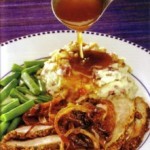While this roast could be prepared in an oven, smoking it over apple and cherry wood adds another dimension of flavor to complement the peppercorn and mustard glaze. A boneless pork loin could also be substituted for the bone-in sirloin roast. (This entrée does require some advance preparation; be sure to read all the recipes before proceeding as some of the steps are interrelated.)
Ingredients
Roast
- 1 5 lb bone-in pork sirloin roast
- 4-5 cloves garlic
- 2-3 tbsp Dijon mustard
- 2 tsp brown sugar
- 2 tsp dried thyme
- 1 tbsp black peppercorn
- 1 tbsp green peppercorns, drained
- 1 tbsp pink peppercorns
- 1 tsp yellow mustard seeds
- 1 1/2 tsp coarse, kosher salt
Gravy
- 4 tbsp pork fat, divided
- 2 mediumyellow onions, thinkly sliced
- 2 tbsp flour
- 2 1/2 cups apple cider
Servings: people
Instructions
- Trim excess fat from roast, reserve. Peel garlic cloves and slice into slivers. Using a sharp paring knife, cut into the pork roast in several areas and insert slices of garlic at varying depths. (If desired, the roast may be tied between the bones to help retain its shape during cooking as the outer layer tends to separate from the rib-eye muscle.) Brush Dijon mustard onto the meat.
- Using the side of a chef’s knife, a rolling pin, or a small spice grinder coarsely crack peppercorns and mustard seeds. In a small mixing bowl, combine brown sugar, thyme, peppercorns, mustard seeds and salt. Liberally apply rub to roast. (If desired, the roast could be prepared to this point one day ahead and held, wrapped in food film and refrigerated.) Allow the roast to come to room temperature before cooking.
- In a small saucepan, melt pork fat over medium low heat until fat renders, about 10 to 15 minutes, being careful not to allow the fat to burn. Remove cracklings, reserve if desired. Strain fat and reserve. (Depending on the amount of fat, it should render to about 1/3 to 1/2 cup.)
Prepping the Grill Dome
- Fill the Grill Dome firebox with hardwood lump charcoal and light the charcoal. Allow the temperature to stabilize at 360 degrees F. to 370 degrees F. (This will take about 30 to 45 minutes depending on the size of your Grill Dome and the amount and type of fuel. For my Grill Dome, the bottom vent should be open about 1/2 to 3/4 of an inch and the top vent about 10 percent to maintain the desired temperature.) Add two pieces of apple wood and two pieces of cherry wood to the charcoal.
- Chef’s note: I installed a BBQ Guru Competitor power draft on the Grill Dome to regulate the fire although ceramic cookers, once stabilized, will hold temperature for quite some time without using a power draft unit. For my cooker, I clipped the grate probe onto the cooking grate next to the roast and inserted the “meat set point” probe into the roast, being careful not to touch any bone. Set the “meat set point” temperature alarm to 150 degrees F. and the “pit set point” regulator to 350 degrees F.
- Place the pork on the cooking grate and roast 25 to 30 minutes per pound (about 2 1/2 to three hours) or until the pork has an internal temperature of 145 degrees F. Remove the roast from the grill and bring it into the kitchen. Tent with aluminum foil and let stand for 10 to 15 minutes before slicing.
The Gravy
- In a partially covered saucepan over medium heat, reduce 2 1/2 cups of apple cider to 1 1/2 cups, about 15 to 20 minutes. In a medium sauté pan over medium heat, heat two tablespoons of pork fat and cook onions until caramelized, about eight to 10 minutes (a pinch of granulated sugar will help caramelize the onions). Remove from heat, remove onions and reserve (do not clean pan, it will be used later to prepare the gravy).
- Using the same sauté pan as for the onions, melt two tablespoons of pork fat (or unsalted butter) over medium high heat; add flour and cook, stirring constantly, to a blonde roux. Add reduced cider, reduce heat and simmer for three to four minutes Add two-thirds of the sautéed onions (reserve remaining onions for garnish). Return gravy to a simmer and cook for two to three minutes. (The gravy may be prepared ahead and held, refrigerated, for up to two hours. If the gravy is too thick, thin it with some apple cider or chicken stock.)
Share this Recipe
Powered byWP Ultimate Recipe
The following two tabs change content below.


Publisher | Christened the "Pope of Peppers" by The New York Times, Dave DeWitt is a food historian and one of the foremost authorities in the world on chile peppers, spices, and spicy foods.
Latest posts by Dave DeWitt (see all)
- Enchiladas Verdes con Chile Pasado - 02/08/2023
- Smoked Oysters with Ancho Chile Sauce - 01/13/2023
- Machaca Sierra Madre - 01/11/2023







